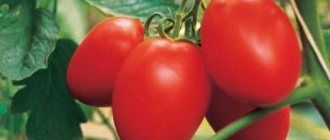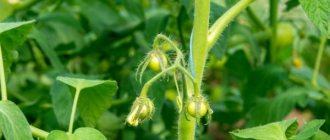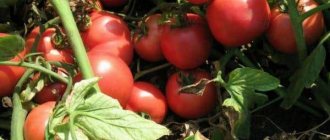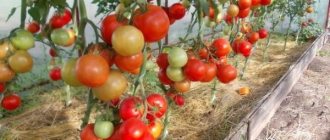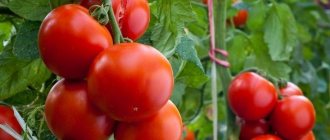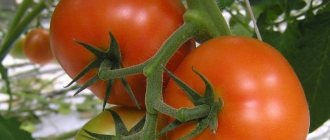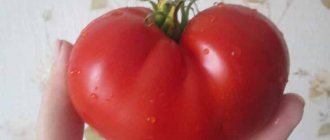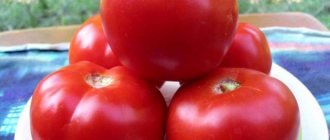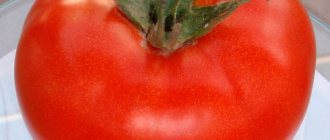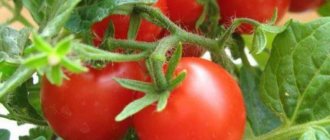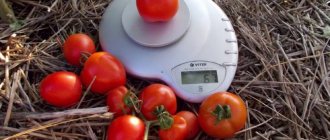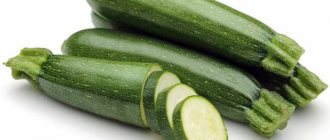Description
The creators describe the plant as a medium-sized, semi-determinate type, up to 75 cm high. Although, according to reviews, in a greenhouse a tomato grows more than 2 meters in height. The foliage is moderate, the leaves are simple, small in size, dark green, slightly wrinkled. The stems are very powerful and require gartering to a trellis. In the southern regions, where cultivation in open ground is possible, President is grown as a stake crop, that is, with a garter on a support or stakes. The originator recommends forming the plant into 1 - 2 stems. There are few stepchildren, which makes care easier. Inflorescence of intermediate type. The first fruit cluster is placed above the 7th - 9th leaf. Each brush can form up to 8 ovaries.
The fruits are large, even, dense. Weight from 200 to 300 grams. The shape is flat-round. At the stage of technical ripeness, the color is light green, there is a faint green spot near the stalk. At the moment of ripeness, the stain disappears, and the fruit turns an even bright red color. The pulp is fleshy, moderately dense, sweetish. The originators indicate the taste as excellent, but those who grew the variety note, in general, a mediocre taste.
Advantages and disadvantages
President F1 tomatoes are often grown by Russian gardeners and farmers, as they have many advantages:
- Decent yield.
- Excellent presentation and taste.
- Long-term storage and resistance to transportation.
- Easy to care for.
- Versatility of use.
- Suitable for growing in open ground and greenhouses.
Important! The President tomato can be grown in any region of Russia, as it is resistant to various climatic conditions and external factors.
Experienced gardeners note several disadvantages of this hybrid:
- The need to tie up long stems.
- It is necessary to install supports under the brushes, since 5-6 tomatoes weighing 300 g each are formed on each one. Due to the large weight, the brushes may break off.
- In the northern regions, it is better to use a greenhouse to cultivate this hybrid.
Characteristics
- The President hybrid is early ripening; 90–100 days pass from the emergence of seedlings to the start of ripening. According to the description of the originators, the first ripe tomatoes appear 68 - 70 days after transplanting the seedlings to a permanent place;
- The tomato yield is excellent - up to 8 kg of fruit is harvested from one bush in a greenhouse; of course, to achieve such results, the growing technology must be strictly followed;
- I would especially like to mention the immunity of the variety - the plant is resistant to many diseases. Among them: verticillium wilt, fusarium wilt (races 1, 2), tobacco mosaic virus, gray leaf spot, Alternaria stem cancer, nematode;
- transportation capabilities are excellent, fruit shelf life is also good;
- The use of tomatoes is universal. Used for fresh consumption and canning.
Reviews from those who planted
Next, we invite you to read real reviews from gardeners who have repeatedly cultivated the President variety of tomatoes and recommend growing these tomatoes on their plots.
Irina Viktorovna, Krasnoyarsk region
Olga Lvovna, Samara region
Viktor Pavlovich, Moscow region
Elvira Eduardovna, Leningrad region
Natalya Viktorovna, Perm region
Irina Anatolyevna, Bryansk region
Polina Alexandrovna, Moscow region
Valentina Petrovna, Volgograd region
Agricultural technology
It is recommended to grow President through seedlings. Tomato seeds are sown 55 - 60 days before planting in a permanent place. Usually sowing is carried out in early March. In the phase of 2 true leaves, picking is carried out, hardening is carried out 2 weeks before transplantation. Those who have grown this variety note that it is demanding of nutrients. Therefore, during planting, complex mineral fertilizers must be applied to the hole. During the formation of the crop, alternate organic matter and mineral compounds, for example, Kemira. Watering is moderate, as needed, and only with warm water. The best method of irrigation is drip irrigation. The greenhouse must have sufficient lighting. Planting density - 4 pieces per 1 square meter.
How to grow tomato seedlings yourself
The President tomato variety is recommended for all regions, but in the north it should be grown in greenhouses, and in the south of the country its seeds can be sown in the ground. However, due to the long period of fruiting, the seedling method of cultivation would be preferable.
Optimal timing
Early ripe tomatoes are sown at a time that depends on the region and growing conditions. In central Russia, they are sown at the end of March, but if the tomatoes are planted in a greenhouse, they can be sown earlier. Tomato seedlings of the “President” variety are planted in a permanent place at the age of 50–55 days from emergence.
Soil mixture
It is worth taking care of preparing the soil for seedlings. You can buy it, or you can prepare the following mixture - mix garden soil with peat (humus) and sand in a 1:1:1 ratio. You can add a half-liter jar of ash and 20 g of superphosphate to the prepared soil mixture. The finished mixture must be disinfected. You can use the following methods:
- pour boiling water or a solution of potassium permanganate;
- bake in the oven at +80…+90 °C;
- treat with a 3% solution of copper sulfate.
Planting, growing and caring for rhubarb in open ground, when you can collect it and how to propagate it
Growing container
The seedling container can be any of your choice:
- Boxes. Their advantage is the possibility of reusable use and ease of transportation. It is important that the plants do not outgrow them and do not closely intertwine their roots. Plants should be removed from them carefully.
- Plastic cassettes. They require searching for a pallet and are difficult to transport.
- Plastic cups. They are convenient to use and inexpensive, but they are not easy to transport. They are often replaced with homemade products made from plastic bottles. You need to make drainage holes in them yourself.
- Peat cups and tablets. They additionally nourish plants, but are more expensive and require more frequent moistening.
- Seedling pots. Reusable containers, ideal for seedlings. Tomatoes need pots 12–17 cm deep and the same width. Their disadvantage is that they take up a lot of space, are difficult to transport, and plants must be removed from them with care.
Seed preparation
Before planting in the ground, it is recommended to disinfect seed material by placing it in a light pink solution of potassium permanganate for 20 minutes. Then it should be rinsed well. To ensure the germination of seeds, they must be germinated before sowing.
To do this, they are distributed over damp gauze and covered with it on top. At the same time, they can withstand temperatures of about +22…+30 °C. Every day the seeds are checked for germination and the moisture content of the tissue is monitored. They usually appear in the next few days. To improve seed germination, you can add stimulants (for example, Epin) when soaking.
Sowing seeds
Seeds are sown immediately in separate pots or in one seedling container, followed by picking in the phase of 2-3 leaves. The soil is moistened before sowing. Furrows are made with a depth of about 1 cm and row spacing of 4 cm. The seeds are placed in them at a distance of 2 cm from each other, then covered and slightly compacted on top with soil.
When sowing a seed in a separate container, it can be buried 1 cm in the center of the pot using a pencil. After sowing, the soil is sprayed from above with water, and the container itself is covered with film and placed in a warm place (+25 ° C). Every day the film is opened, the moisture content is checked and aired for 20 minutes.
Seedling care
When sprouts appear, the container with tomato sprouts is transferred to a illuminated place with a lower temperature of +15...+18 °C. Tomatoes are light-loving crops and it is best for them to choose the most illuminated window (south, east, west). Otherwise, you will have to illuminate this crop with a fluorescent lamp for up to 12 hours of daylight, placing it on top of the plants.
The seedlings should be watered during the day with settled warm water at +25…+28 °C. Tender sprouts are not watered at first, but sprayed, preventing the soil from drying out, or the soil is moistened with a syringe. Tomato seedlings, starting from two weeks of age, can be fed with superphosphate or complex fertilizers containing phosphorus and potassium. Before planting in the ground, such fertilizing is done 2 more times.
Hardening of seedlings
A few weeks before planting, the seedlings begin to harden off. This is done in warm weather by placing containers of tomatoes on the balcony. First, the tomatoes spend a little time there (30 minutes). Then the time period is gradually increased and on the last day the plants are already outside for the whole day. At the same time, the balcony window opens, and the seedlings gradually get used to the sun's rays. If there is no balcony, then you can open a window for hardening. There should be no drafts.
President 2
This hybrid appeared relatively recently and is considered an improved version of its predecessor. The Monsanto Corporation filed an application for its registration in 2005, and 2 years later the variety was entered into the State Plant Register of the Russian Federation with approval for all regions of Russia. Recommended for open ground in private farms, it can also be grown indoors. Suitable for industrial cultivation.
Summary
President F1 is an excellent all-purpose hybrid tomato. This variety can be grown in a greenhouse, on the ground or on a farmer's field - the tomato shows high yield everywhere. There are no difficulties in caring for the crop, but do not forget that the plant is indeterminate - the bushes must be constantly tied up and pinched.
In general, the President variety is excellent for growing on an industrial scale, for those who sell their own fresh produce. This tomato will be an excellent “lifesaver” for ordinary gardeners, because its yields are stable and practically independent of external factors.
Description
The plant is indeterminate, vigorous, requiring obligatory garter on a trellis. The foliage is moderate. The leaves are small, dark green, alternately arranged. The surface of the sheet plate is matte, slightly corrugated. Inflorescence of intermediate type. Pedicel with articulation. The originators promise high formation of ovaries. The first brush is formed under the 7th - 8th leaf. Each brush has 5-6 ovaries.
The fruits are flat-round, ribbed, dense, large, weighing 340 - 360 grams. An unripe tomato is light green in color, while a ripened one takes on an orange-red hue. The pulp is fleshy, juicy, dense - when cutting into salad, the amount of liquid released is minimal. The number of seed nests is 4. The taste is excellent; according to reviews, fruits that ripen for several days at room temperature have the best taste.
Characteristics
- President 2 is also an early ripening breed. From the moment the seeds germinate until the beginning of ripening, 95 - 100 days pass. The harvest appears 75 days after planting the seedlings;
- The yield of the variety is about 5 - 7 kg per bush. According to the State Plant Register of the Russian Federation - 4.7 kg;
- tomatoes are not prone to cracking;
- tomato is resistant to tobacco mosaic virus and fusarium wilt;
- The crop tolerates transportation over long distances very well;
- The shelf life of the fruit is excellent - can be stored for up to 3 weeks;
- The way to eat tomatoes is universal. The fruits are used in their natural form, ideal for summer vegetable salad, any type of canning, and processed into juice and paste.
The agricultural technology of President 2 is no different from its predecessor.
The advantages of both varieties are excellent immunity, high commercial quality of tomatoes and universal use of the crop. The downside is the inability to independently collect seed material for further cultivation and the high price of sold seeds.
Features of care
Tomatoes of the hybrid variety President 2 require special care. The bushes grow large, so they definitely need to be tied up. You need to form a bush into 1 stem. During the entire growth period, pinching and thinning of foliage should be carried out. It is better to remove stepchildren by hand rather than with a knife.
If the plant is grown in a greenhouse, you need to constantly monitor the temperature. At night, the air temperature should not be lower than 16℃. During active ripening, the temperature should be increased by 2℃. The greenhouse should be well ventilated or equipped with a good ventilation system.
